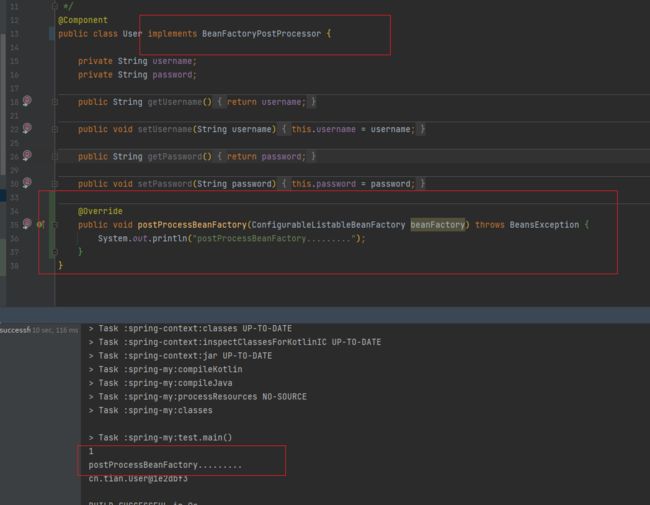Spring源码之BeanFactoryPostProcessor(后置处理器)。
有点水平的Spring开发人员想必都知道BeanFactoryPostProcessor也就是常说的后置管理器,这是Spirng生命周期中的一个接口,实现这个接口可以在beanFactory初始化前做一些事。
我们熟知的Spring和Mybatis的结合,正是因为Mybatis实现了BeanFactoryPostProcessor,它的重要性不言而喻,深入理解他对于切入Mybatis源码有着深刻的意义。
如下图是简单的应用:
还是先贴上refresh()的源码
@Override
public void refresh() throws BeansException, IllegalStateException {
synchronized (this.startupShutdownMonitor) {
// Prepare this context for refreshing.
//1、刷新前的准备
prepareRefresh();
// Tell the subclass to refresh the internal bean factory.
//2、将会初始化 BeanFactory、加载 Bean、注册 Bean
ConfigurableListableBeanFactory beanFactory = obtainFreshBeanFactory();
// Prepare the bean factory for use in this context.
//3、设置 BeanFactory 的类加载器,添加几个 BeanPostProcessor,手动注册几个特殊的 bean
prepareBeanFactory(beanFactory);
try {
//4、模板方法
// Allows post-processing of the bean factory in context subclasses.
postProcessBeanFactory(beanFactory);
// Invoke factory processors registered as beans in the context.
//执行BeanFactory后置处理器
invokeBeanFactoryPostProcessors(beanFactory);
// 5、Register bean processors that intercept bean creation.
//注册bean后置处理器
registerBeanPostProcessors(beanFactory);
// Initialize message source for this context.
//国际化
initMessageSource();
// Initialize event multicaster for this context.
initApplicationEventMulticaster();
// Initialize other special beans in specific context subclasses.
//6、模板方法--springboot实现了这个方法
onRefresh();
// Check for listener beans and register them.
//7、注册监听器
registerListeners();
// Instantiate all remaining (non-lazy-init) singletons.
//8、完成bean工厂的初始化**方法**********************************************
finishBeanFactoryInitialization(beanFactory);
//9、 Last step: publish corresponding event.
finishRefresh();
}
catch (BeansException ex) {
if (logger.isWarnEnabled()) {
logger.warn("Exception encountered during context initialization - " +
"cancelling refresh attempt: " + ex);
}
// Destroy already created singletons to avoid dangling resources.
destroyBeans();
// Reset 'active' flag.
cancelRefresh(ex);
// Propagate exception to caller.
throw ex;
}
finally {
// Reset common introspection caches in Spring's core, since we
// might not ever need metadata for singleton beans anymore...
resetCommonCaches();
}
}
}
benafactory源码的处理位于第三个位置。
主要涉及到两个方法postProcessBeanFactory(beanFactory);
和invokeBeanFactoryPostProcessors(beanFactory);
postProcessBeanFactory(beanFactory)点进去发现是一个空方法,具体的执行在invokeBeanFactoryPostProcessors(beanFactory);中
我们在invokeBeanFactoryPostProcessors方法上打断点一探究竟。第一次看的时候觉得这是什么玩意,这么长,耐住性子一步步的往下看。
方法虽长大概总结一下就是,判断beanFactory类型,然后将注册的BeanPostFactory放入、排好顺序、执行。
invokeBeanFactoryPostProcessors 方法的内容其实比较少,大部分过程在注释都已经写清楚,这边在稍微总结一下。
整个 invokeBeanFactoryPostProcessors 方法围绕两个接口,BeanDefinitionRegistryPostProcessor 和 BeanFactoryPostProcessor,其中 BeanDefinitionRegistryPostProcessor 继承了 BeanFactoryPostProcessor 。
BeanDefinitionRegistryPostProcessor 主要用来在常规 BeanFactoryPostProcessor 检测开始之前注册其他 Bean 定义,说的简单点,就是 BeanDefinitionRegistryPostProcessor 具有更高的优先级,执行顺序在 BeanFactoryPostProcessor 之前。
具体的过程看注释吧
public static void invokeBeanFactoryPostProcessors(
ConfigurableListableBeanFactory beanFactory, List beanFactoryPostProcessors) {
// Invoke BeanDefinitionRegistryPostProcessors first, if any.
Set processedBeans = new HashSet<>();
// 1.判断beanFactory是否为BeanDefinitionRegistry,beanFactory为DefaultListableBeanFactory,
// 而DefaultListableBeanFactory实现了BeanDefinitionRegistry接口,因此这边为true
if (beanFactory instanceof BeanDefinitionRegistry) {
BeanDefinitionRegistry registry = (BeanDefinitionRegistry) beanFactory;
// 用于存放普通的BeanFactoryPostProcessor
List regularPostProcessors = new ArrayList<>();
// 用于存放BeanDefinitionRegistryPostProcessor
List registryProcessors = new ArrayList<>();
// 2.首先处理入参中的beanFactoryPostProcessors
// 遍历所有的beanFactoryPostProcessors, 将BeanDefinitionRegistryPostProcessor和普通BeanFactoryPostProcessor区分开
for (BeanFactoryPostProcessor postProcessor : beanFactoryPostProcessors) {
if (postProcessor instanceof BeanDefinitionRegistryPostProcessor) {
// 2.1 如果是BeanDefinitionRegistryPostProcessor
BeanDefinitionRegistryPostProcessor registryProcessor =
(BeanDefinitionRegistryPostProcessor) postProcessor;
// 2.1.1 直接执行BeanDefinitionRegistryPostProcessor接口的postProcessBeanDefinitionRegistry方法
registryProcessor.postProcessBeanDefinitionRegistry(registry);
// 2.1.2 添加到registryProcessors(用于最后执行postProcessBeanFactory方法)
registryProcessors.add(registryProcessor);
}
else {
// 2.2 否则,只是普通的BeanFactoryPostProcessor
// 2.2.1 添加到regularPostProcessors(用于最后执行postProcessBeanFactory方法)
regularPostProcessors.add(postProcessor);
}
}
// Do not initialize FactoryBeans here: We need to leave all regular beans
// uninitialized to let the bean factory post-processors apply to them!
// Separate between BeanDefinitionRegistryPostProcessors that implement
// PriorityOrdered, Ordered, and the rest.
// 用于保存本次要执行的BeanDefinitionRegistryPostProcessor
List currentRegistryProcessors = new ArrayList<>();
// First, invoke the BeanDefinitionRegistryPostProcessors that implement PriorityOrdered.
// 3.调用所有实现PriorityOrdered接口的BeanDefinitionRegistryPostProcessor实现类
// 3.1 找出所有实现BeanDefinitionRegistryPostProcessor接口的Bean的beanName
String[] postProcessorNames =
beanFactory.getBeanNamesForType(BeanDefinitionRegistryPostProcessor.class, true, false);
// 3.2 遍历postProcessorNames
for (String ppName : postProcessorNames) {
// 3.3 校验是否实现了PriorityOrdered接口
if (beanFactory.isTypeMatch(ppName, PriorityOrdered.class)) {
// 3.4 获取ppName对应的bean实例, 添加到currentRegistryProcessors中,
currentRegistryProcessors.add(beanFactory.getBean(ppName, BeanDefinitionRegistryPostProcessor.class));
// 3.5 将要被执行的加入processedBeans,避免后续重复执行
processedBeans.add(ppName);
}
}
// 3.6 进行排序(根据是否实现PriorityOrdered、Ordered接口和order值来排序)
sortPostProcessors(currentRegistryProcessors, beanFactory);
// 3.7 添加到registryProcessors(用于最后执行postProcessBeanFactory方法)
registryProcessors.addAll(currentRegistryProcessors);
// 3.8 遍历currentRegistryProcessors, 执行postProcessBeanDefinitionRegistry方法
invokeBeanDefinitionRegistryPostProcessors(currentRegistryProcessors, registry);
// 3.9 执行完毕后, 清空currentRegistryProcessors
currentRegistryProcessors.clear();
// Next, invoke the BeanDefinitionRegistryPostProcessors that implement Ordered.
// 4.调用所有实现了Ordered接口的BeanDefinitionRegistryPostProcessor实现类(过程跟上面的步骤3基本一样)
// 4.1 找出所有实现BeanDefinitionRegistryPostProcessor接口的类, 这边重复查找是因为执行完上面的BeanDefinitionRegistryPostProcessor,
// 可能会新增了其他的BeanDefinitionRegistryPostProcessor, 因此需要重新查找
postProcessorNames = beanFactory.getBeanNamesForType(BeanDefinitionRegistryPostProcessor.class, true, false);
for (String ppName : postProcessorNames) {
// 校验是否实现了Ordered接口,并且还未执行过
if (!processedBeans.contains(ppName) && beanFactory.isTypeMatch(ppName, Ordered.class)) {
currentRegistryProcessors.add(beanFactory.getBean(ppName, BeanDefinitionRegistryPostProcessor.class));
processedBeans.add(ppName);
}
}
sortPostProcessors(currentRegistryProcessors, beanFactory);
registryProcessors.addAll(currentRegistryProcessors);
// 4.2 遍历currentRegistryProcessors, 执行postProcessBeanDefinitionRegistry方法
invokeBeanDefinitionRegistryPostProcessors(currentRegistryProcessors, registry);
currentRegistryProcessors.clear();
// Finally, invoke all other BeanDefinitionRegistryPostProcessors until no further ones appear.
// 5.最后, 调用所有剩下的BeanDefinitionRegistryPostProcessors
boolean reiterate = true;
while (reiterate) {
reiterate = false;
// 5.1 找出所有实现BeanDefinitionRegistryPostProcessor接口的类
postProcessorNames = beanFactory.getBeanNamesForType(BeanDefinitionRegistryPostProcessor.class, true, false);
for (String ppName : postProcessorNames) {
// 5.2 跳过已经执行过的
if (!processedBeans.contains(ppName)) {
currentRegistryProcessors.add(beanFactory.getBean(ppName, BeanDefinitionRegistryPostProcessor.class));
processedBeans.add(ppName);
// 5.3 如果有BeanDefinitionRegistryPostProcessor被执行, 则有可能会产生新的BeanDefinitionRegistryPostProcessor,
// 因此这边将reiterate赋值为true, 代表需要再循环查找一次
reiterate = true;
}
}
sortPostProcessors(currentRegistryProcessors, beanFactory);
registryProcessors.addAll(currentRegistryProcessors);
// 5.4 遍历currentRegistryProcessors, 执行postProcessBeanDefinitionRegistry方法
invokeBeanDefinitionRegistryPostProcessors(currentRegistryProcessors, registry);
currentRegistryProcessors.clear();
}
// Now, invoke the postProcessBeanFactory callback of all processors handled so far.
// 6.调用所有BeanDefinitionRegistryPostProcessor的postProcessBeanFactory方法(BeanDefinitionRegistryPostProcessor继承自BeanFactoryPostProcessor)
invokeBeanFactoryPostProcessors(registryProcessors, beanFactory);
// 7.最后, 调用入参beanFactoryPostProcessors中的普通BeanFactoryPostProcessor的postProcessBeanFactory方法
invokeBeanFactoryPostProcessors(regularPostProcessors, beanFactory);
}
else {
// Invoke factory processors registered with the context instance.
invokeBeanFactoryPostProcessors(beanFactoryPostProcessors, beanFactory);
}
// Do not initialize FactoryBeans here: We need to leave all regular beans
// uninitialized to let the bean factory post-processors apply to them!
// 到这里 , 入参beanFactoryPostProcessors和容器中的所有BeanDefinitionRegistryPostProcessor已经全部处理完毕,
// 下面开始处理容器中的所有BeanFactoryPostProcessor
// Do not initialize FactoryBeans here: We need to leave all regular beans
// uninitialized to let the bean factory post-processors apply to them!
// 8.找出所有实现BeanFactoryPostProcessor接口的类
String[] postProcessorNames =
beanFactory.getBeanNamesForType(BeanFactoryPostProcessor.class, true, false);
// Separate between BeanFactoryPostProcessors that implement PriorityOrdered,
// Ordered, and the rest.
// 用于存放实现了PriorityOrdered接口的BeanFactoryPostProcessor
List priorityOrderedPostProcessors = new ArrayList<>();
// 用于存放实现了Ordered接口的BeanFactoryPostProcessor的beanName
List orderedPostProcessorNames = new ArrayList<>();
// 用于存放普通BeanFactoryPostProcessor的beanName
List nonOrderedPostProcessorNames = new ArrayList<>();
// 8.1 遍历postProcessorNames, 将BeanFactoryPostProcessor按实现PriorityOrdered、实现Ordered接口、普通三种区分开
for (String ppName : postProcessorNames) {
// 8.2 跳过已经执行过的
if (processedBeans.contains(ppName)) {
// skip - already processed in first phase above
}
else if (beanFactory.isTypeMatch(ppName, PriorityOrdered.class)) {
// 8.3 添加实现了PriorityOrdered接口的BeanFactoryPostProcessor
priorityOrderedPostProcessors.add(beanFactory.getBean(ppName, BeanFactoryPostProcessor.class));
}
else if (beanFactory.isTypeMatch(ppName, Ordered.class)) {
// 8.4 添加实现了Ordered接口的BeanFactoryPostProcessor的beanName
orderedPostProcessorNames.add(ppName);
}
else {
// 8.5 添加剩下的普通BeanFactoryPostProcessor的beanName
nonOrderedPostProcessorNames.add(ppName);
}
}
// First, invoke the BeanFactoryPostProcessors that implement PriorityOrdered.
// 9.调用所有实现PriorityOrdered接口的BeanFactoryPostProcessor
// 9.1 对priorityOrderedPostProcessors排序
sortPostProcessors(priorityOrderedPostProcessors, beanFactory);
// 9.2 遍历priorityOrderedPostProcessors, 执行postProcessBeanFactory方法
invokeBeanFactoryPostProcessors(priorityOrderedPostProcessors, beanFactory);
// Next, invoke the BeanFactoryPostProcessors that implement Ordered.
// 10.调用所有实现Ordered接口的BeanFactoryPostProcessor
List orderedPostProcessors = new ArrayList<>();
for (String postProcessorName : orderedPostProcessorNames) {
// 10.1 获取postProcessorName对应的bean实例, 添加到orderedPostProcessors, 准备执行
orderedPostProcessors.add(beanFactory.getBean(postProcessorName, BeanFactoryPostProcessor.class));
}
// 10.2 对orderedPostProcessors排序
sortPostProcessors(orderedPostProcessors, beanFactory);
// 10.3 遍历orderedPostProcessors, 执行postProcessBeanFactory方法
invokeBeanFactoryPostProcessors(orderedPostProcessors, beanFactory);
// Finally, invoke all other BeanFactoryPostProcessors.
// 11.调用所有剩下的BeanFactoryPostProcessor
List nonOrderedPostProcessors = new ArrayList<>();
for (String postProcessorName : nonOrderedPostProcessorNames) {
// 11.1 获取postProcessorName对应的bean实例, 添加到nonOrderedPostProcessors, 准备执行
nonOrderedPostProcessors.add(beanFactory.getBean(postProcessorName, BeanFactoryPostProcessor.class));
}
// 11.2 遍历nonOrderedPostProcessors, 执行postProcessBeanFactory方法
invokeBeanFactoryPostProcessors(nonOrderedPostProcessors, beanFactory);
// Clear cached merged bean definitions since the post-processors might have
// modified the original metadata, e.g. replacing placeholders in values...
// 12.清除元数据缓存(mergedBeanDefinitions、allBeanNamesByType、singletonBeanNamesByType),
// 因为后处理器可能已经修改了原始元数据,例如, 替换值中的占位符...
beanFactory.clearMetadataCache();
}


